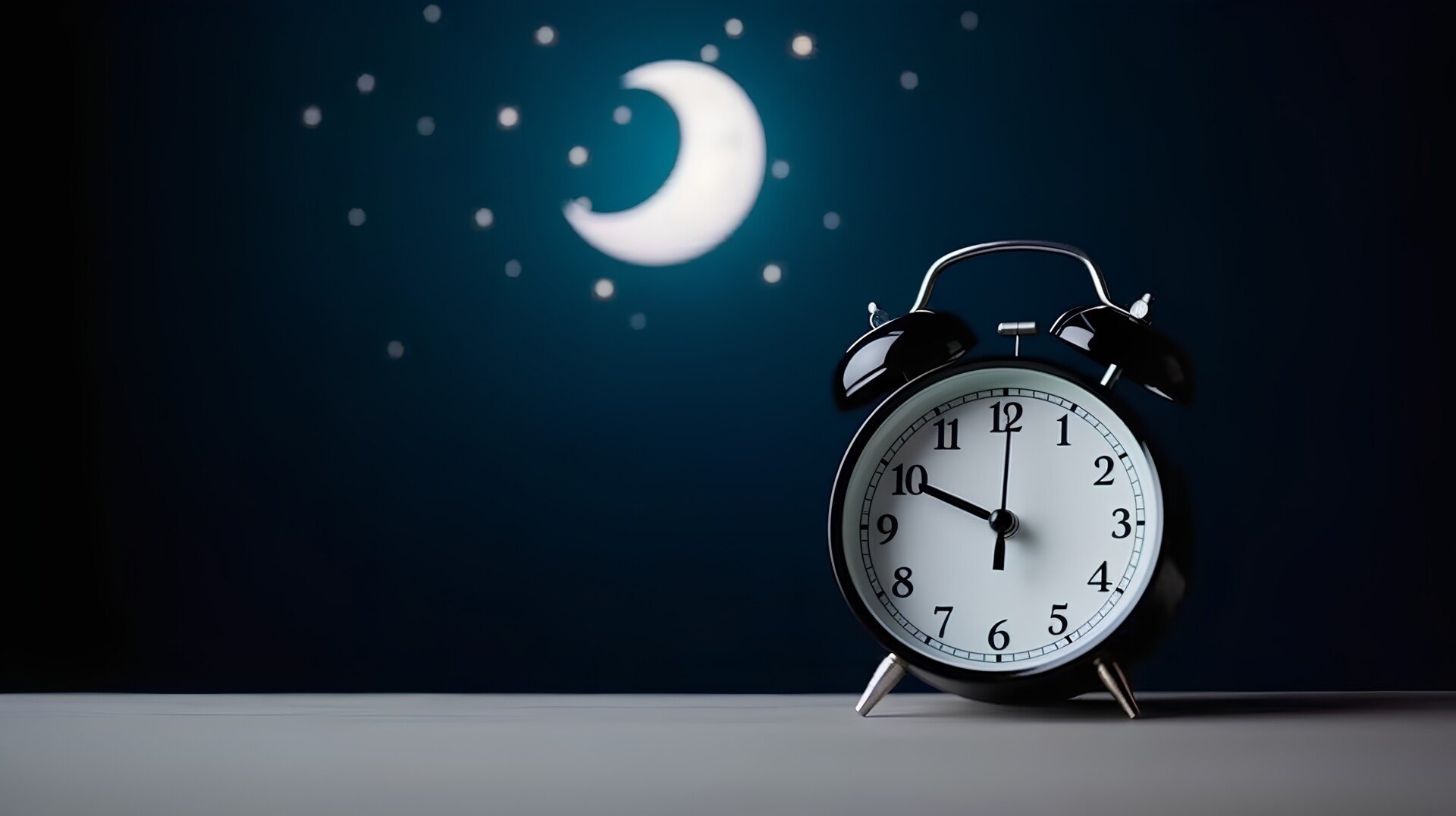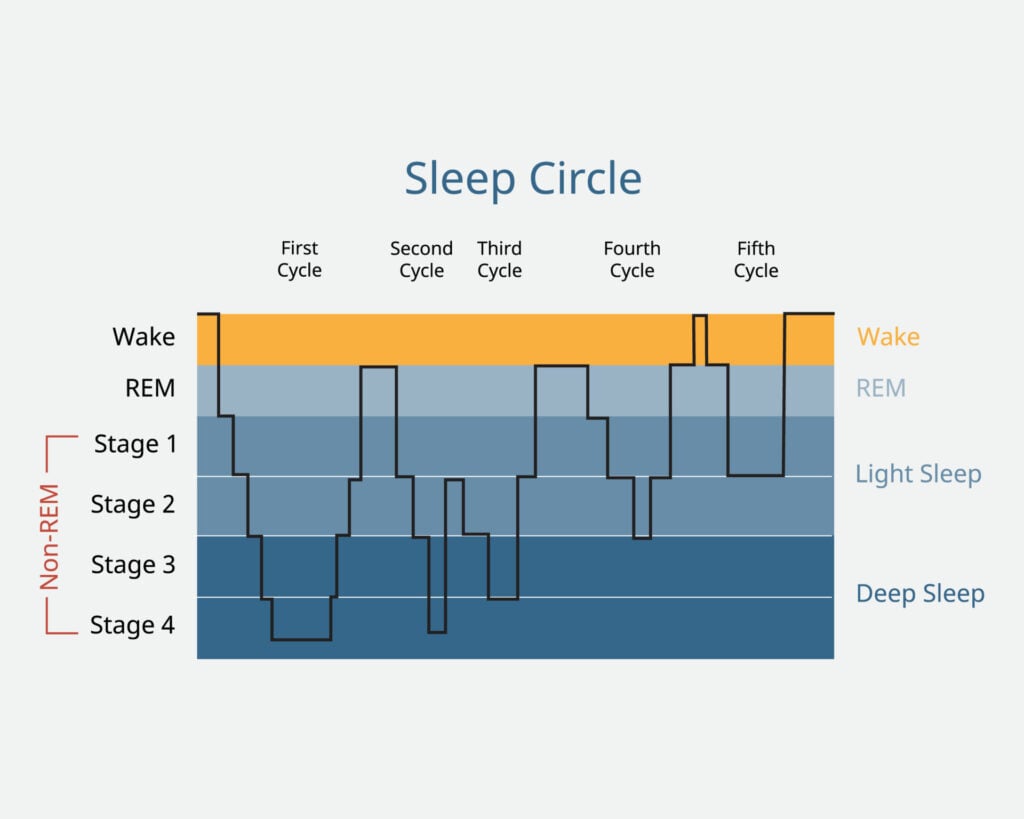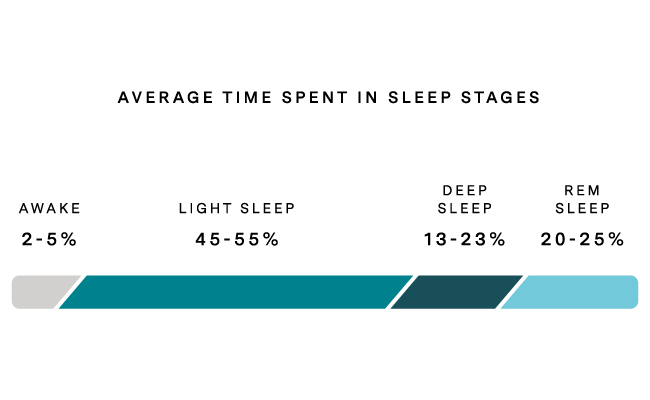What Are The Stages Of Sleep & What Does Each Stage Do?
- There are five different sleep stages, including REM (rapid eye movement) and NREM (non-rapid eye movement) sleep. The five stages make one sleep cycle, which usually repeats every 90 to 110 minutes.
- Stage 1 non-REM sleep marks the transition from wakefulness to sleep. This stage typically lasts less than 10 minutes and is marked by a slowing of your heartbeat, breathing, eye movements, and the relaxation of your muscles.
- Stage 2 non-REM sleep is a period of light sleep before you enter deeper sleep, which lasts roughly 20 minutes. Stage two is characterized by further slowing of both the heartbeat and breathing and the brain begins to produce bursts of rapid, rhythmic brain wave activity known as sleep spindles.
- Formerly known as stages 3 and 4, stage 3 (N3) is the final stage of non-REM sleep. This is the deepest period of sleep and lasts 20 to 40 minutes. Your heartbeat and breathing slow to their lowest levels, and your muscles are so relaxed that it may be hard to awaken you.
- Stage 5 REM sleep occurs 90 minutes after sleep onset and is a much deeper sleep than any of the three stages of non-REM sleep. REM sleep is defined by rapid eye movements and an almost complete paralysis of the body, and a tendency to dream.

Put simply, sleep is a state of perceptual disengagement from and unresponsiveness to the environment, marked by unique physiological and behavioral processes (Carskadon & Rechtschaffen, 2011).
During wakefulness, certain neurons fire in our brains, making us aroused and alert. However, during sleep, these neural circuits are inhibited, our muscles are completely relaxed, and our body becomes completely inactive (Schwartz & Roth, 2008).
Introduction to Sleep
Though research reveals that it is much more complicated, the levels of consciousness can be thought of in three components: conscious, preconscious, and unconscious, as originally defined by Sigmund Freud.
- The conscious state of awareness is classified as being aware of and responsive to one’s surroundings (wakefulness).
- The preconscious mind consists of thoughts currently outside of conscious awareness but is available for recall and capable of becoming conscious (Freud & Strachey, 1984).
- Unconsciousness is marked by an inability to respond to external stimuli, no awareness of the self and the environment, and no evidence of language comprehension or expression – it is a state of unresponsiveness (Massimini et al., 2009).
A sleeping person, for example, is in a state of unconsciousness; so is an individual in a coma or someone who has fainted. The difference, however, is that a sleeping person can be aroused if the stimulus is strong enough (for example, shaking the person, shining a bright light, or making a loud noise).
Once awake, you are back in a state of consciousness, aware of your surroundings.
The Circadian Rhythm
But how do our bodies know when to go back and forth between sleep and wakefulness? Luckily, we all have an internal clock telling us when to do so. The circadian rhythm, our 24-hour clock, operates as our sleep/wake cycle.
This body clock is located in the suprachiasmatic nucleus (SCN), a pair of distinct groups of cells located in the hypothalamus (Dubokovich, 2007).
It controls the production of melatonin, a hormone that makes you sleepy, by receiving information about incoming light from the eyes (Dubokovich, 2007).
When there is less light (like at night), the SCN tells the brain to make more melatonin so you get drowsy and are able to fall asleep. After a night’s rest, melatonin levels will drop, and you will be awake for the day.
REM and Non-REM Sleep
Sleep has been traditionally divided into two categories: Non-rapid eye movement (NREM) and rapid eye movement (REM).
Non-REM Sleep
Non-REM sleep is marked by a reduction of physiological activity as bodily functions slow down. There are three phases of non-REM sleep, commonly referred to as N1, N2, and N3.
Each stage is marked by unique characteristics and differs from the others in terms of the depth of sleep or the degree of the sensory and motor disconnects.
During non-REM sleep, electrical activity in the brain slows, growth hormone secretion occurs, and there is a decrease in muscle activity, heart rate, respiration, and oxygen consumption (Purves et al., 2001).
Non-REM sleep is regulated by many brain structures, especially that of the thalamus and the cerebral cortex (De Andrés, Garzón, & Reinoso-Suárez, 2011).
REM Sleep
REM sleep, on the other hand, is marked by intense brain activity and is a much more active period of sleep than non-REM.
This stage is heavily regulated by the brainstem (McCarley et al., 1995), which is the region of the brain that connects the cerebrum with the spinal cord. It consists of the midbrain, medulla oblongata, and pons.
REM sleep occurs after the brain passes through stages one, two, and three and typically occurs approximately every 90 minutes (McCarley et al., 1995).
During REM sleep, brain activity increases, voluntary muscles are inhibited, and rapid eye movements and dreams occur (McCarley et al., 1995). The next section will go into more detail on REM sleep as well as the characteristics of the specific stages of non-REM sleep.
Sleep Stages
In 1957, William Dement, along with Nathaniel Kleitman, came out with another revolutionary paper that discussed the specific sleep stages that together form the internal cycle that occurs every night we sleep (Dement & Kleitman, 1957).
Stage 1: lightest sleep
Stage 1 is the first stage of non-REM sleep (N1). This stage typically lasts less than 10 minutes (Altevogt & Colten, 2006) and is marked by a slowing of your heartbeat, breathing, and eye movements (Lockett, 2020), as well as the relaxation of your muscles.
Your brain waves also begin to slow down as you have entered a stage of light sleep.
In the beginning of stage 1, the brain produces high-amplitude alpha waves and begins to produce theta waves as the stage progresses (Abeln et al., 2014). Put simply; brainwaves are electrical pulses in the brain that change according to what we are doing or how we are feeling (Abhang et al., 2016).
As the waves slow down (a decrease in frequency or cycles per second), the brain goes into a deeper sleep.
Alpha waves are the highest frequency (thus, the fastest) of the three brain waves that characterize sleep, explaining why, when we have just fallen asleep and are not yet in a state of deep sleep, we can be easily awoken.
Stage 2: light sleep
Stage 2 (N2) is still a period of light sleep, marked by similar characteristics as in N1, such as a continued slowing of both the heartbeat and breathing and the muscles relaxing even further than in N1 (Lockett, 2020).
In this stage, your body temperature drops, and your eye movements stop completely (Lockett, 2020).
Stage 2 is characterized by theta waves (Abeln et al., 2014), but the brain also begins to produce bursts of rapid, rhythmic brain wave activity known as sleep spindles, which are important for learning and memory (Fogel & Smith, 2011).
In addition to sleep spindles is the presence of k-complexes, high amplitude patterns of brain activity that may occur in response to environmental stimuli (Forget et al., 2011). In total, N2 lasts roughly 20 minutes long (Altevogt & Colten, 2006).
Stages 3 & 4: deep sleep
Formerly known as stages 3 and 4, stage 3 (N3) is the final stage of non-REM sleep. During N3, your heartbeat and breathing slow to their lowest levels, and your muscles are so relaxed that it may be hard to awaken you (Lockett, 2020).
This stage is referred to as “slow wave sleep” due to the presence of delta waves, or slow brain waves, as the brain is now in a deeper state of sleep as compared to N1 and N2 (Abeln et al., 2014).
Sleepwalking and night terrors are also unique characteristics of N3 (Singh et al., 2018).
Sleepwalking, or somnambulism, occurs when sleeping and waking are combined, and the individual wanders around in a dazed and uncoordinated state (Kales et al., 1980). Night terrors are partial waking from sleep during which behaviors such as screaming, kicking, and panic occur (Kales et al., 1980).
Both sleepwalking and night terrors more commonly happen in children than adults. Slow-wave sleep is also associated with bodily recovery and certain types of learning (Tononi & Cirelli, 2006).
Additionally, it is in this stage that human growth hormone (HGH) is released. HGH works to restore and rebuild your body and muscles from the stresses of the day (Iyo, 2020). N3 lasts between 20 to 40 minutes long (Altevogt & Colten, 2006).
Stage 5: REM sleep
REM sleep is a much deeper sleep than any of the three stages of non-REM sleep.
REM sleep is defined by rapid eye movements and an almost complete paralysis of the body, otherwise known as REM atonia, where motor neurons are completely inhibited (McCarley et al., 1995).
In this stage, brainwaves are fast and low amplitude, similar to the pattern seen during wakefulness, as measured by electroencephalography (EEG; Brown & McCarley, 2008).
EEG is an electrophysiological monitoring method to record the electrical activity of the brain, and this technology is commonly used in sleep studies to measure brainwave activity (Niedermeyer & da Silva, 2004).
At birth, humans spend about one-third of a 24-hour day in REM sleep. As we mature, the percentage of REM sleep declines rapidly so that by approximately age 10, the adult percentage of REM sleep is reached roughly 20-25% of total sleep time (McCarley et al., 1995).
However, REM rebound, or the increase of REM sleep above normal levels, can occur after a period of sleep deprivation (Verma et al., 2001). That is, there is an increase in REM sleep after a night of little REM sleep.
A key characteristic of REM sleep is the presence of dreams. Dreams are a succession of images, ideas, emotions, and sensations that usually occur involuntarily in the mind (Tirapu-Ustarroz, 2012).
Evidence of dreams occurring during REM sleep is illustrated by studies in which subjects who are awakened from REM sleep recall elaborate, vivid, emotional dreams, as opposed to subjects awakened during non-REM sleep who report fewer, less vivid dreams (Purves et al., 2001).
While the meaning of dreams and why we dream is still relatively unknown, theories suggest that we may dream as we consolidate memories (Pace-Schott, 2013), prepare for possible future threats (Valli et al. 2005), reflect unconscious mental function in a psychoanalytic way (Eiser, 2005), or help further develop cognitive capabilities (Medrano-Martinez & Ramos-Platón, 2014).
The Sleep Cycle
Your body cycles through these stages four to five times each night. Cycles earlier in the night tend to have more NREM sleep, while later cycles have a higher proportion of REM.
By the final cycle, your body may even skip NREM deep sleep entirely.

Overall, your body spends more time in the NREM phases of sleep

Sleep Cycles in Other Animals
Humans may be unique in a lot of ways, but the fact that we sleep is not one of them. As discussed, sleep is important for recovery, memory storage, and growth, so it makes perfect sense that other animals need sleep, too.
However, the length of sleep, brain’s state of consciousness, and whether dreaming occurs differs among species.
But do all animals even sleep? Research has shown that birds and mammals sleep (Siegel, 2008).
That is, they become unconscious of their surroundings for a certain period of time. Reptiles sleep, but research is inconclusive regarding whether they reach a REM sleep-like state.
Fish and amphibians reduce their state of awareness but do not ever become unconscious (Siegel, 2008). Insects, on the other hand, do not appear to sleep (and have never been shown to enter REM sleep), although they may experience periods of inactivity (McCarley et al., 1995).
It is important to understand that while other animals also sleep, different types of animals have different sleep cycles.
Birds and mammals share non-REM and REM sleep, but for birds, both cycles are much shorter – non-REM averages roughly two and a half minutes, while REM lasts about only nine seconds (Ogden, 2015).
The length of these cycles also ranges from mammal to mammal. For example, REM sleep occurs for 24 minutes in a cat and 12 minutes in a rat (McCarley et al., 1995).
Although research on reptile sleep cycles is not completely conclusive, a 2016 study on the brain of a lizard, the Australian dragon, revealed that slow wave and REM sleep patterns oscillated continuously with a period of roughly 80 seconds each (Shein-Idelson et al., 2016).
Now that we know other animals also sleep, and some even alternate between cycles of REM and non-REM, just as humans do, you might be wondering if other animals dream.
By studying brainwaves and stages of sleep, research supports the claim that both mammals and birds dream, as both groups enter REM sleep where dreaming occurs.
It is possible that reptiles dream since past studies reveal they also exhibit some form of REM sleep (Libourel et al., 2018; Shein-Idelson et al., 2016), but researchers are still uncertain as to whether this is completely true.
And while it is difficult to discern whether animals do dream, it is even more challenging to understand the specific content of these dreams. It becomes clear that further research is necessary for this field.
When Should I Set My Alarm?
An individual sleep cycle typically lasts around ninety minutes to two hours, during which the brain cycles from slow-wave sleep to REM sleep. However, the sleep cycle is not as simple as cycling through the stages sequentially.
As the night progresses, the amount of time we spend in specific stages changes, as does the order of the stages.
For example, the average length of the first non-REM-REM sleep cycle is 70 to 100 minutes.
The second and subsequent cycles last longer – approximately 90 to 120 minutes (Carskadon & Rechtschaffen, 2011).
In adults, REM sleep increases as the night progress and is the longest in the last one-third of the time spent asleep. N2 begins to account for the majority of non-REM sleep, and N3 can even disappear altogether (Altevogt & Colten, 2006).
On an average night, adults typically need to complete at least four or five sleep cycles per night, or 7 to 9 total hours of sleep (Hirshkowitz et al., 2015). However, there is a large degree of variability from person to person and from night to night (Carskadon & Rechtschaffen, 2011).
Babies, for example, have shorter sleep cycles, lasting only about 50 minutes for the first nine months of life, and it is typical for newborns to sleep anywhere from 14 to 18 hours a day (Hirshkowitz et al., 2015).
Most professionals agree that shorter naps are better if a person’s goal is to wake up feeling refreshed and alert. However, the results of a 2019 study indicated that 25-, 35-, and even 45-minute naps significantly reduced signs of stress and fatigue in physically active men (Hsouna, 2019).
It also improved their attention and physical performance. The National Sleep Foundation warns that taking longer naps may leave you feeling groggy, as you will need to wake up from a deeper sleep.
In sum, if you want to take a nap, make sure it isn’t too short that you don’t wake up feeling refreshed or too long that you interrupt your REM sleep and feel even more tired than you did before your nap. Just like in Goldilocks, the length of your nap must be just right!
And when it is time to go to sleep for the night, make sure you are giving yourself a minimum of 7 hours of sleep. The bottom line is that sleep is important, and you should make sure to get enough sleep every day!
William Dement: The Father of Sleep
How do we know anything about sleep if we are, well, asleep? We can’t administer a questionnaire mid-nap or have people have a conversation while unconscious. Fortunately, we have a man named Dr. William Dement to thank for most of what we know about sleep.
Dr. Dement, known as the “Father of Sleep Medicine,” is a Washington state native who had dreams of becoming a journalist.
Unfortunately, all of the journalism classes at the University of Washington were full, so Dement opted to enroll in an Introduction to Psychology course instead.
He found this class to be so interesting that he scrapped his plans of becoming a journalist and decided he wanted to become a psychoanalyst (Stanford, 2008).
After attending the University of Washington, Dement went on to the University of Chicago School of Medicine, where the only person studying sleep was faculty member Nathaniel Kleitman (Stanford, 2008).
The two began to work together in the 1950s, making some of the greatest sleep discoveries in the field. Their first discovery, in 1953, was that of rapid eye movement (REM) sleep (Aserinsky & Kleitman, 1953).
FAQs
How long is a sleep cycle?
A typical sleep cycle lasts about 90 to 110 minutes, consisting of different stages: non-REM sleep stages 1, 2, 3, and the REM (Rapid Eye Movement) stage. Most adults experience 4 to 6 of these cycles per night.
How long is a REM cycle?
A REM (Rapid Eye Movement) cycle, in which most dreaming occurs, varies in length throughout the night. The first REM cycle is typically short, about 10 minutes, and occurs 90 minutes after falling asleep. Subsequent REM cycles lengthen, with the final one lasting up to an hour.
How do brain waves change as a sleeper progresses from stage 1 sleep to rem sleep?
As a sleeper progresses from stage 1 sleep to REM (Rapid Eye Movement) sleep, brain waves undergo distinct changes. In stage 1 sleep, brain waves slow down with irregular patterns known as theta waves.
In contrast, during REM sleep, brain waves become faster and more similar to the waves observed during wakefulness. This is when vivid dreaming occurs, and the brain shows increased activity and resembles the alert state. These transitions between sleep stages reflect different aspects of sleep and the corresponding brain activity.
References
Abeln, V., Kleinert, J., Strüder, H. K., & Schneider, S. (2014). Brainwave entrainment for better sleep and post-sleep state of young elite soccer players–A pilot study. European Journal of Sport Science, 14 (5), 393-402.
Abhang, P. A., Gawali, B. W., & Mehrotra, S. C. (2016). Introduction to EEG-and speech-based emotion recognition. Academic Press.
Altevogt, B. M., & Colten, H. R. (Eds.). (2006). Sleep disorders and sleep deprivation: an unmet public health problem. National Academies Press.
Aserinsky, E., & Kleitman, N. (1953). Regularly occurring periods of eye motility, and concomitant phenomena, during sleep. Science, 118 (3062), 273-274.
Brown, R. E., & McCarley, R. W. (2008). Neuroanatomical and neurochemical basis of wakefulness and REM sleep systems. In Neurochemistry of sleep and wakefulness/Eds.: JM Monty, SR Pandi-Perumal, CM Sinton (p. 23).
Carskadon, M. A., & Rechtschaffen, A. (2011). Monitoring and staging human sleep. Principles and practice of sleep medicine, 5, 16-26.
De Andrés, I. T., Garzón, M., & Reinoso-Suárez, F. (2011). Functional anatomy of non-REM sleep. Frontiers in neurology, 2, 70.
Dement, W., & Kleitman, N. (1957). Cyclic variations in EEG during sleep and their relation to eye movements, body motility, and dreaming. Electroencephalography and clinical neurophysiology, 9 (4), 673-690.
Dubocovich, M. L. (2007). Melatonin receptors: role on sleep and circadian rhythm regulation. Sleep medicine, 8, 34-42.
Eiser, A.S. (2005). Physiology and psychology of dreams. Seminars in Neurology 25, 97–105.
Fogel, S. M., & Smith, C. T. (2011). The function of the sleep spindle: a physiological index of intelligence and a mechanism for sleep-dependent memory consolidation. Neuroscience & Biobehavioral Reviews, 35 (5), 1154-1165.
Forget, D., Morin, C. M., & Bastien, C. H. (2011). The role of the spontaneous and evoked k-complex in good-sleeper controls and in individuals with insomnia. Sleep, 34 (9), 1251-1260.
Freud, S., & Strachey, J. (1984). On Metapsychology: the theory of psychoanalysis: ‘Beyond the pleasure principle,’ The ego and the id and other works. Penguin.
Hirshkowitz, M., Whiton, K., Albert, S. M., Alessi, C., Bruni, O., DonCarlos, L., … & Neubauer, D. N. (2015). National Sleep Foundation’s sleep time duration recommendations: methodology and results summary. Sleep health, 1 (1), 40-43.
Hsouna, H., Boukhris, O., Abdessalem, R., Trabelsi, K., Ammar, A., Shephard, R. J., & Chtourou, H. (2019). Effect of different nap opportunity durations on short-term maximal performance, attention, feelings, muscle soreness, fatigue, stress and sleep. Physiology & behavior, 211, 112673.
Iyo, J. (2020). How Sleep Affects Your Human Growth Hormone (HGH) Levels. Retrieved from https://www.tuck.com/sleep-hgh/
Kales, A., Soldatos, C. R., Bixler, E. O., Ladda, R. L., Charney, D. S., Weber, G., & Schweitzer, P. K. (1980). Hereditary factors in sleepwalking and night terrors. Br J Psychiatry, 137 (2), 111-118.
Libourel, P. A., Barrillot, B., Arthaud, S., Massot, B., Morel, A. L., Beuf, O., … & Luppi, P. H. (2018). Partial homologies between sleep states in lizards, mammals, and birds suggest a complex evolution of sleep states in amniotes. PLoS biology, 16 (10), e2005982.
Lockett, E. (2020). The Stages of Sleep: What Happens During Each. Retrieved from https://www.healthline.com/health/healthy-sleep/stages-of-sleep
Massimini, M., Boly, M., Casali, A., Rosanova, M., & Tononi, G. (2009). A perturbational approach for evaluating the brain’s capacity for consciousness. Progress in brain research, 177, 201-214.
McCarley, R. W., Greene, R. W., Rainnie, D., & Portas, C. M. (1995). Brainstem neuromodulation and REM sleep. In Seminars in neuroscience (Vol. 7, No. 5, pp. 341-354). Academic Press.
Medrano-Martinez, P., & Ramos-Platón, M. J. (2014). Generation and functions of dreams. Revista de neurologia, 59 (8), 359-370.
Niedermeyer, E., & da Silva, F. L. (Eds.). (2005). Electroencephalography: basic principles, clinical applications, and related fields.
Lippincott Williams & Wilkins.
Ogden, D. (2015). How do birds sleep? Retrieved from https://ca.audubon.org/news/how-do-birds-sleep
Pace-Schott, E. F. (2013). Dreaming as a story-telling instinct. Frontiers in Psychology, 4, 159.
Purves, D., Augustine, G. J., Fitzpatrick, D., Katz, L. C., LaMantia, A. S., McNamara, J. O., & Williams, S. M. (2001). Physiological changes in sleep states. Neuroscience . 2nd edn. Sunderland, MA: Sinauer Associates.
Schwartz, J. R., & Roth, T. (2008). Neurophysiology of sleep and wakefulness: basic science and clinical implications. Current neuropharmacology, 6 4), 367-378.
Shein-Idelson, M., Ondracek, J. M., Liaw, H. P., Reiter, S., & Laurent, G. (2016). Slow waves, sharp waves, ripples, and REM in sleeping dragons. Science, 352 (6285), 590-595.
Siegel, J. M. (2008). Do all animals sleep? Trends in neurosciences, 31 (4), 208-213.
[Stanford]. (2008). A Tribute for William C. Dement [Video file]. Retrieved from https://www.youtube.com/watch?v=UWkeI45kbNU
Tirapu-Ustarroz, J. (2012). Neuropsychology of dreams. Revista de Neurologia, 55 (2), 101-110.
Tononi, G., & Cirelli, C. (2006). Sleep function and synaptic homeostasis. Sleep medicine reviews, 10 (1), 49-62.
Valli, K., Revonsuo, A., Pälkäs, O., Ismail, K. H., Ali, K. J., & Punamäki, R. L. (2005). The threat simulation theory of the evolutionary function of dreaming: Evidence from dreams of traumatized children. Consciousness and cognition, 14 (1), 188-218.
Verma, A., Radtke, R. A., VanLandingham, K. E., King, J. H., & Husain, A. M. (2001). Slow wave sleep rebound and REM rebound following the first night of treatment with CPAP for sleep apnea: correlation with subjective improvement in sleep quality. Sleep medicine, 2 (3), 215-223.


